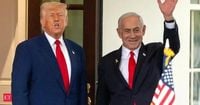In a dramatic turn of events at the White House on September 30, 2025, former US President Donald Trump and Israeli Prime Minister Benjamin Netanyahu stood side by side to announce what Trump hailed as a near-breakthrough in securing a ceasefire deal for Gaza. The press briefing, which began more than an hour late, was filled with bold assertions, high-stakes diplomacy, and a palpable sense of urgency as the leaders outlined a plan that, if accepted, could bring an end to nearly two years of war in the Palestinian enclave.
Trump declared, “We’re at a minimum, very, very close. And I think we’re beyond, very close,” describing the moment as “one of the greatest days in civilization.” According to The Economic Times, the proposed ceasefire deal is multifaceted: it calls for the release of living Israeli captives within 72 hours, the return of the bodies of those who have died, and an immediate end to hostilities. The plan also stipulates that Arab and Muslim leaders would take responsibility for demilitarizing Gaza and dismantling Hamas’s military capabilities.
Trump emphasized that the plan was developed after “extensive consultation with friends and partners across the region,” and he claimed broad support from Arab and Muslim leaders, as well as European allies. He specifically praised leaders from Saudi Arabia, Qatar, the UAE, Jordan, Turkey, Indonesia, Pakistan, and Egypt—many of whom he met at the United Nations General Assembly the previous week. “There have been great men helping, and some great women too, but they tend to be mostly men however,” Trump remarked, a comment that drew a few awkward smiles in the room.
Central to the proposal is the formation of a new transitional authority in Gaza, which would oversee a phased withdrawal of Israeli forces. Trump also announced the creation of an international oversight body, the Board of Peace, which he described as “beautiful” and revealed he would chair himself. Former British Prime Minister Tony Blair was named as a founding member, with other members to be announced in the coming days.
“If Hamas chooses to reject the 20-point proposal,” Trump warned, “then ‘Bibi’—referring to Netanyahu—would have our full backing to do what you have to do.” Shortly after the press conference, Qatar and Egypt confirmed they had delivered the proposal to Hamas, raising hopes that a response might soon be forthcoming.
Trump’s speech was peppered with references to the suffering of both Israelis and Palestinians. He claimed, “There are many Palestinians who wish to live in peace. Many, many, many. I’ve seen so many of them. They have support. I challenge Palestinians to take control of their destiny.” He added, “We’re giving them responsibility for their destiny,” but emphasized that peace would require a firm prohibition of terrorism and significant reforms by the Palestinian Authority. “If the Palestinian Authority does not complete the reforms that I laid out in my vision for peace in 2020, they’ll have only themselves to blame. We’re giving them an amazing footprint.”
Turning his attention to the destruction wrought by the conflict, Trump asserted, “It’s a different Hamas we’re dealing with, as 20,000 people have been killed. Their leadership has been killed three times over.”
Netanyahu, taking the podium after Trump, offered effusive praise for the former president, calling him “the greatest friend that Israel has ever had in the White House” and stating, “the competition isn’t even close.” According to Haaretz, Netanyahu said, “When our nations stand shoulder to shoulder, we achieve the impossible,” referencing the US’s “bold decision” to help Israel during its 12-day war with Iran in June, which he claimed “made the region safer, and the world safer.”
Netanyahu expressed his support for the peace plan, stating that Hamas would be disarmed and that Gaza would be administered by a civilian authority—neither Hamas nor the Palestinian Authority. This stance runs counter to European calls for recognition of a Palestinian state under PA governance. He also made clear his rejection of a Palestinian state, arguing that it “would endanger Israel’s very existence.”
“Under your leadership, we can re-energize the Abraham Accords and expand them to more Arab and Muslim nations,” Netanyahu said. He ended his remarks with a sweeping vision: “Israel and America can change the face of the Middle East.”
Trump, for his part, seemed undeterred by recent escalations in the region. At the press conference, he floated the possibility of Iran joining the Abraham Accords, despite the deep-seated animosity between Iran and Israel. “Who knows, maybe even Iran can get in there,” Trump mused, as reported by Reuters. “I think they’re going to be open to it. I really believe that. But they could be a member.” He added, “We hope we’re going to be able to get along with Iran.”
These remarks came just over three months after a fierce proxy war between Israel and Iran, which began on June 13, 2025. As detailed by Al Jazeera and The Economic Times, the conflict saw more than 200 Israeli fighter jets strike over 100 Iranian nuclear and military facilities, as well as residential neighborhoods. Iran retaliated with hundreds of ballistic missiles targeting Israeli cities, resulting in casualties on both sides. The United States entered the fray on June 22, launching strikes on Iran’s Natanz, Fordow, and Isfahan nuclear facilities.
The financial toll of these conflicts is mounting. On the same day as the White House briefing, the Knesset approved a breach of the 2025 budget ceiling and an increase in the deficit to cover the growing costs of war. According to Haaretz, this move reflects the severe financial strain on Israel from both the Gaza conflict and the recent war with Iran. The budget increase is a stark reminder that, even as leaders pursue peace, the costs of war continue to reverberate through Israeli society.
The peace plan unveiled by Trump and Netanyahu is ambitious: it calls for a ceasefire, exchange of hostages, staged Israeli withdrawal, Hamas disarmament, and a transitional government led by an international body. Yet, major questions remain. Will Hamas accept the terms? Can a transitional authority truly govern Gaza in the absence of both Hamas and the Palestinian Authority? And is it realistic to imagine Iran joining the Abraham Accords after such a violent summer?
As the world waits for Hamas’s response, the stakes could not be higher. The leaders’ optimism is palpable, but the region’s history is littered with failed peace efforts and dashed hopes. For now, the world watches and waits, hoping that the “historic first” proclaimed at the White House will mark not just another chapter, but a genuine turning point for the Middle East.





